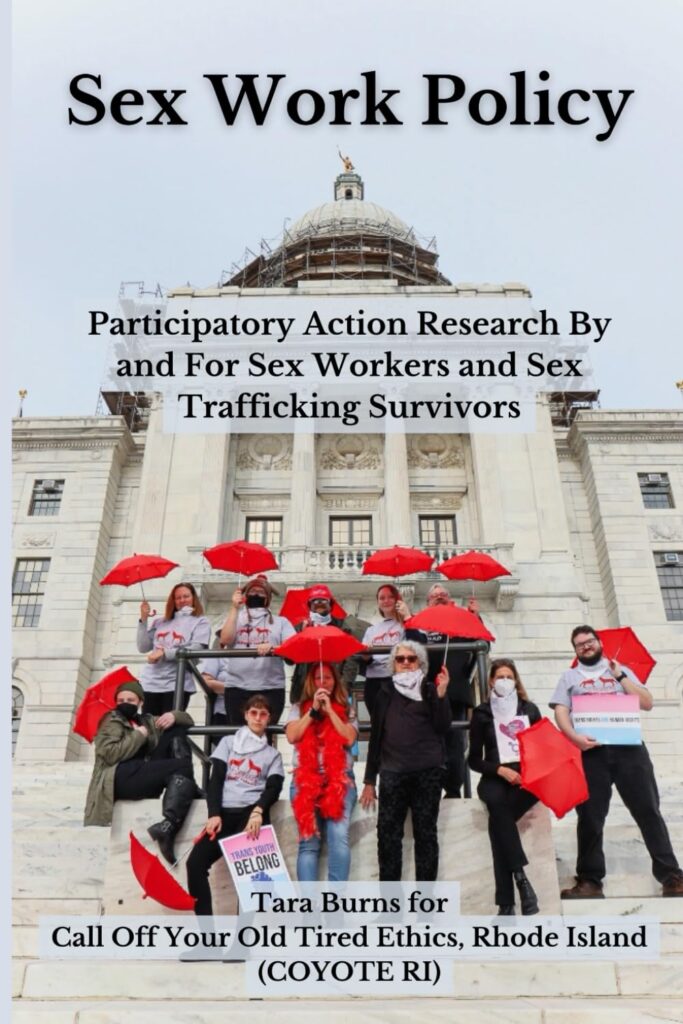The cover of the book “Sex Work Policy” depicts activists on the steps in front of the Rhode Island State House. Tara Burns, one of the book’s authors, advocated for sex worker rights in Alaska. (Detail of book cover)
The recently published book “Sex Work Policy: Participatory Action Research By Sex Workers and Sex Trafficking Survivors” is an accessible and powerful read, making complex policies digestible for those without a policy background. Balanced with depth and clarity, Sex Work Policy allows readers to understand better what sex workers are going through and what can be done to improve our lives.
With the combination of research, personal stories, and clear actionable policy recommendations, it stands as one of the most valuable resources for anyone looking to understand the realities of sex work in the U.S.
It was written by sex workers and sex trafficking survivors with a participatory action research methodology, which involves the active participation of those affected by the research. The lived experiences of those in the sex industry make it a must read for anyone wanting to understand the impact of policies on health, safety, and working conditions.
Each of the 13 chapters tackles a different aspect of the sex industry, from policing to public services, and the realities of the federal law enacted in 2018, Fight Online Sex Trafficking Act. Spoiler: It’s bad.
One standout chapter is “People in Alaska’s Sex Trade – Their Lived Experiences and Policy Recommendations,” by Tara Burns. Burns is a founding member of Community United for Safety and Protection, a sex trafficking survivor, and a researcher. With an M.A. in her back pocket, she was the first registered lobbyist in Alaska to advocate for sex worker rights. She currently serves as the research and policy director for COYOTE RI, an organization that advocates for policies that promote the health and safety of people involved in the sex industry in Rhode Island.
Burns brings valuable insights into Alaska’s sex trade, explaining methods, the demographics of participants, and the survey results with clarity. “Sex Work Policy” manages to take topics that can be dry with academic jargon, translating the subject matter into something insightful and actionable. The real power lies in the firsthand accounts of sex workers and sex trafficking survivors in Alaska. This is a clear look at how current state and federal sex trafficking laws warp the lives of people in the sex trade.
Chapter 7 compares surveys conducted in the U.S., Rhode Island, and Alaska. Examining trafficking, exploitation, violence, and arrest rates, the data exposes the reality that many in the sex industry face daily. For instance, 74% of Alaskan respondents reported being the victim or witness of a crime they didn’t report. These are crimes that could have been prevented or addressed but weren’t because of a system that treats sex workers and sex trafficking survivors as criminals, even when trying to seek help. This chapter offers pragmatic recommendations for law enforcement, highlighting the need for policies requiring police to take reports from sex workers without the threat of arrest.
Whether you’re interested in the legal ramifications of current policies or the health consequences they impose, “Sex Work Policy” doesn’t just outline the problems; there are concrete recommendations to improve conditions for sex workers and sex trafficking survivors.
“Sex Work Policy” offers practical solutions rooted in the experiences of those who’ve lived it. Whether you’re interested in an overview of national policies or how policies in Alaska have affected those in the sex industry, this book is both a learning tool and a call to action.
“Sex Work Policy”is a guide to the changes needed to protect the health and safety of sex workers and sex trafficking survivors in Alaska and across the U.S.
GET THE MORNING HEADLINES.

